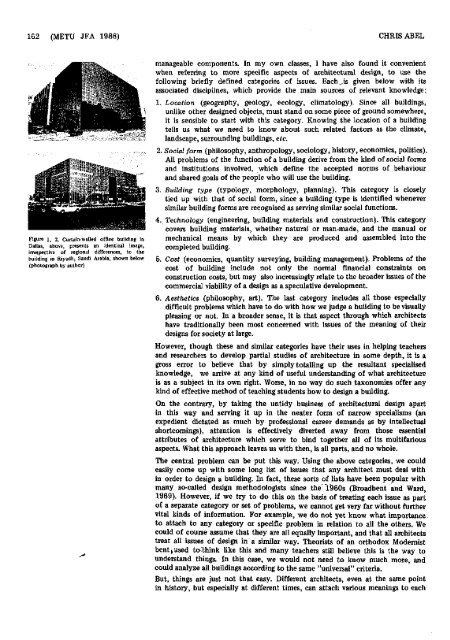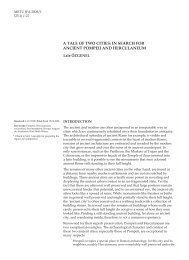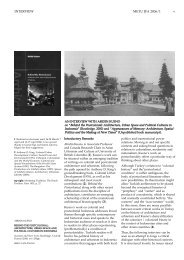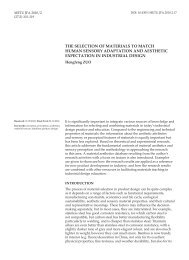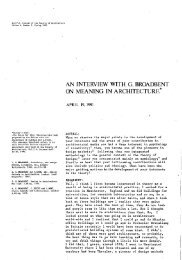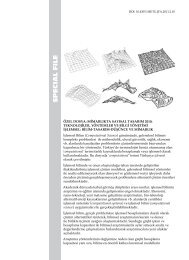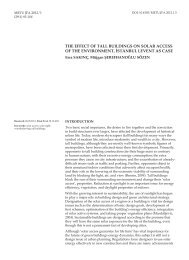ANALOGICAL MODELS IN ARCHITECTURE AND URBAN DESIGN l
ANALOGICAL MODELS IN ARCHITECTURE AND URBAN DESIGN l
ANALOGICAL MODELS IN ARCHITECTURE AND URBAN DESIGN l
Create successful ePaper yourself
Turn your PDF publications into a flip-book with our unique Google optimized e-Paper software.
162 (METU JFA 1988) CHRIS ABEL<br />
Figure l, 2. Curtain-walled office building in<br />
Dallas, above, presents an identical image,<br />
irrespective of regional differences, to the<br />
building in Riyadh, Saudi Arabia, shown below<br />
(photograph by author)<br />
manageable components. In my own classes, I have also found it convenient<br />
when referring to more specific aspects of architectural design, to use the<br />
following briefly defined categories of issues. Eachjs given below with its<br />
associated disciplines, which provide the main sources of relevant knowledge:<br />
1. Location (geography, geology, ecology, climatology). Since all buildings,<br />
unlike other designed objects, must stand on some piece of ground somewhere,<br />
it is sensible to start with this category. Knowing the location of a building<br />
tells us what we need to know about such related factors as the climate,<br />
landscape, surrounding buildings, etc.<br />
2. Social form (philosophy, anthropology, sociology, history, economics, politics).<br />
All problems of the function of a building derive from the kind of social forms<br />
and institutions involved, which define the accepted norms of behaviour<br />
and shared goals of the people who will use the building.<br />
3. Building type (typology, morphology, planning). This category is closely<br />
tied up with that of social form, since a building type is identified whenever<br />
similar building forms are recognised as serving similar social functions.<br />
4. Technology (engineering, building materials and construction). This category<br />
covers building materials, whether natural or man-made, and the manual or<br />
mechanical means by which they are produced and assembled into the<br />
completed building.<br />
5. Cost (economics, quantity surveying, building management). Problems of the<br />
cost of building include not only the normal financial constraints on<br />
construction costs, but may also increasingly relate to the broader issues of the<br />
commercial viability of a design as a speculative development.<br />
6. Aesthetics (philosophy, art). The last category includes all those especially<br />
difficult problems which have to do with how we judge a building to be visually<br />
pleasing or not. In a broader sense, it is that aspect through which architects<br />
have traditionally been most concerned with issues of the meaning of their<br />
designs for society at large.<br />
However, though these and similar categories have their uses in helping teachers<br />
and researchers to develop partial studies of architecture in some depth, it is a<br />
gross error to believe that by simply totalling up the resultant specialised<br />
knowledge, we arrive at any kind of useful understanding of what architecture<br />
is as a subject in its own right. Worse, in no way do such taxonomies offer any<br />
kind of effective method of teaching students how to design a building.<br />
On the contrary, by taking the untidy business of architectural design apart<br />
in this way and serving it up in the neater form of narrow specialisms (an<br />
expedient dictated as much by professional career demands as by intellectual<br />
shortcomings), attention is effectively diverted away from those essential<br />
attributes of architecture which serve to bind together all of its multifarious<br />
aspects. What this approach leaves us with then, is all parts, and no whole.<br />
The central problem can be put this way. Using the above categories, we could<br />
easily come up with some long list of issues that any architect must deal with<br />
in order to design a building. In fact, these sorts of lists have been popular with<br />
many so-called design methodologists since the 1960s (Broadbent and Ward,<br />
1969). However, if we try to do this on the basis of treating each issue as part<br />
of a separate category or set of problems, we cannot get very far without further<br />
vital kinds of information. For example, we do not yet know what importance<br />
to attach to any category or specific problem in relation to all the others. We<br />
could of course assume that they are all equally important, and that all architects<br />
treat all issues of design in a similar way. Theorists of an orthodox Modernist<br />
bent t used to "think like this and many teachers still believe this is the way to<br />
understand things. In this case, we would not need to know much more, and<br />
could analyze all buildings according to the same "universal" criteria.<br />
But, things are just not that easy. Different architects, even at the same point<br />
in history, but especially at different times, can attach various meanings to each


